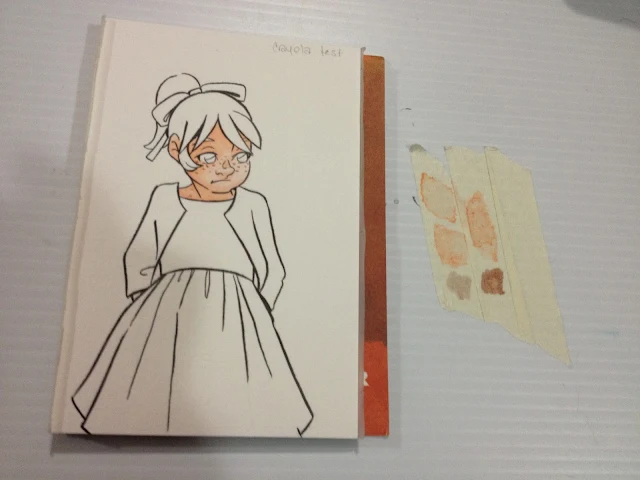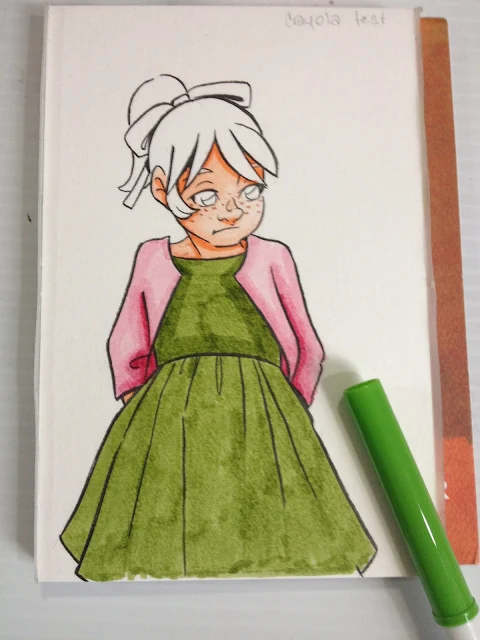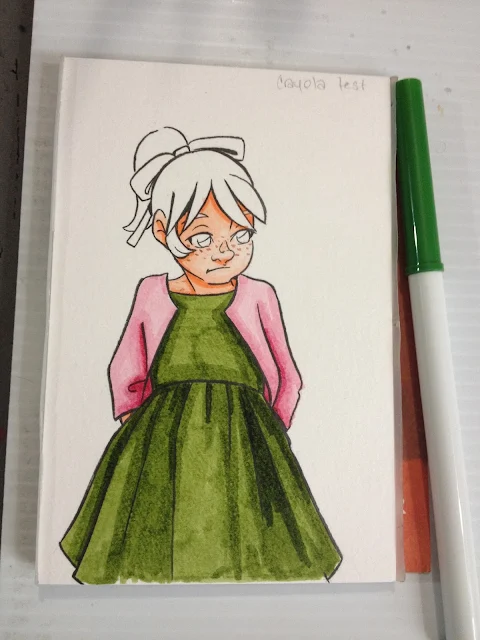Revisiting: Crayola Supertip Markers on Watercolor Paper
In the past few months, I've really cranked up the number of waterbased markers I've reviewed on this blog. I know a few of you probably wonder why, as they have a mediocre reputation among artists and illustrators, but I have a hunch that for many of these markers, it's all in the paper you use. Regular paper like sketchbook paper and cardstocks aren't designed to stand up to the combination of stiff nibs and repeated application of (relatively slow) drying waterbased inks, so I decided to beef up my paper selection, and reached for a wood pulp watercolor paper- Fluid's cold press watercolor blocks. Cotton watercolor papers are great for actual watercolors- soft and absorptive, but I thought the stiff nibs of the Crayola Supertips I'm testing in this post would tear that surface up. Woodpulp watercolor paper like Canson's cheaper options (Montval, Biggie) and Fluid watercolor pads are not always idea for painting on, but I thought they could better stand up to those non-flexible Supertips.
Since writing this post, I've also reviewed Up and Up's Supertip markers, and using cold press, cellulose based watercolor paper has now become a regular feature in my waterbased reviews.
Materials Used in this Post
The Field Test
I was a chicken and used the watercolor marker technique (covered in my original Crayola marker review!) of applying color to Kara's skin, but promised myself that I would dive right in on applying marker directly to the paper for everything else.
Surprisingly, the watercolor paper handles the marker quite well- if you apply deliberate, slow strokes, the paper doesn't show any streaking! I know Walmart sells Canson's watercolor paper, maybe that is the key to applying waterbased markers in a professional way.
If you can work quickly enough, you can get a streak free application of color.
If you give your marker sufficient drying time, you can even layer the waterbased marker without paper surface abrasion. I even became brave and applied a skintone on top of my original skintone application, as a dark shadow, and it looks ok. Keep in mind that while you can layer markers, you can't BLEND them except with water, but that's a technique I've already covered. You can mix the techniques, but make sure your paper is totally dry before you apply marker directly to paper. Since blending marker to marker isn't really an option with the Crayola Supertips, I highly recommend you work closely with your swatch sheet, and make sure your colors match.
Large areas will show some streaking, although its not nearly as bad as on smooth papers like marker paper, sketchbook paper, or cardstock. I recommend working in sections and working carefully if streaking is an issue for you. You can ease color transitions if you apply your basecolor first, allow it to dry, apply your shadow, and then go back with the base color, but keep in mind that with every layer you add, you're darkening your color.
Unlike on sketchbook paper, cardstock, or even marker paper, you can layer without pilling on wood pulp watercolor paper because the surface is strong enough to take a little scrubbing. Make sure you allow your layers to dry before applying another coat, or your paper will pill due to abrasion from the stiff Supertip.
If you are careful and deliberate, you can also do a little bit of blending out, by using your original color on top of your new color, you can ease the transition between the two colors.
I thought the piece looked a little blank without a background wash, so I tried to apply one after everything was finished.
This can be a big mistake, as adding water, especially from a waterbrush, will reactivate other layers of ink you've put down.
Fortunately, it cleans up easily with a paper towel if you can work fast.
It's better to apply the marker wider than you normally would for watercolor markers, then SPARINGLY (and I mean, wipe all the water out of the brush of your waterbrush first) apply water away from the main figure.
I recommend you do your water-based blending first, because doing it at the end will reactivate colors you've already put down, and make a big mess. I'd switched to a waterbrush to apply a blue background, and it lays down WAY too much water (even if I try to dry the tip out a bit), so I do not recommend using a Pentel travel waterbrush for applying washes at the end of your waterbased marker rendering session.
The Verdict
On watercolor paper, these waterbased markers are actually pretty fun to render with, and are far less likely to give you fume headaches the way prolonged exposure to Copics sometimes can. Yes, streaking is still an issue, although far less of an issue than it was on marker paper or cardstock. I realize some of my readers might not have wood pulp based watercolor paper laying around, but I know Canson's cheaper offerings, like their Biggie pads, are wood pulp, and might be worth playing around with if you enjoy using waterbased markers.
More on this blog about Crayola Markers
If you're interested in waterbased markers as an alternative to alcohol based markers, consider reading these watercolor marker reviews as well:
Since writing this post, I've also reviewed Up and Up's Supertip markers, and using cold press, cellulose based watercolor paper has now become a regular feature in my waterbased reviews.
Materials Used in this Post
The Field Test
I was a chicken and used the watercolor marker technique (covered in my original Crayola marker review!) of applying color to Kara's skin, but promised myself that I would dive right in on applying marker directly to the paper for everything else.
Surprisingly, the watercolor paper handles the marker quite well- if you apply deliberate, slow strokes, the paper doesn't show any streaking! I know Walmart sells Canson's watercolor paper, maybe that is the key to applying waterbased markers in a professional way.
If you can work quickly enough, you can get a streak free application of color.
Unlike on sketchbook paper, cardstock, or even marker paper, you can layer without pilling on wood pulp watercolor paper because the surface is strong enough to take a little scrubbing. Make sure you allow your layers to dry before applying another coat, or your paper will pill due to abrasion from the stiff Supertip.
If you are careful and deliberate, you can also do a little bit of blending out, by using your original color on top of your new color, you can ease the transition between the two colors.
I thought the piece looked a little blank without a background wash, so I tried to apply one after everything was finished.
This can be a big mistake, as adding water, especially from a waterbrush, will reactivate other layers of ink you've put down.
Fortunately, it cleans up easily with a paper towel if you can work fast.
It's better to apply the marker wider than you normally would for watercolor markers, then SPARINGLY (and I mean, wipe all the water out of the brush of your waterbrush first) apply water away from the main figure.
I recommend you do your water-based blending first, because doing it at the end will reactivate colors you've already put down, and make a big mess. I'd switched to a waterbrush to apply a blue background, and it lays down WAY too much water (even if I try to dry the tip out a bit), so I do not recommend using a Pentel travel waterbrush for applying washes at the end of your waterbased marker rendering session.
The Verdict
On watercolor paper, these waterbased markers are actually pretty fun to render with, and are far less likely to give you fume headaches the way prolonged exposure to Copics sometimes can. Yes, streaking is still an issue, although far less of an issue than it was on marker paper or cardstock. I realize some of my readers might not have wood pulp based watercolor paper laying around, but I know Canson's cheaper offerings, like their Biggie pads, are wood pulp, and might be worth playing around with if you enjoy using waterbased markers.
More on this blog about Crayola Markers
If you're interested in waterbased markers as an alternative to alcohol based markers, consider reading these watercolor marker reviews as well:
- Watercolor Brush Pen Review: Docrafts Artiste Watercolor Markers
- Watercolor Brushpen Review: Tombow ABT
- Watercolor Pen Review: Marvy LePlumeII
- Watercolor Brushpen Review: Neopiko 4
- Mini Review: Winsor and Newton Watercolor Markers
- Winsor and Newton Watercolor Marker Field Test
- Watercolor Brushpen Review: Zig Art and Graphic Twin
- Watercolor Brush Pen Review: Lyra Aqua Brush Duo






















Comments
Post a Comment